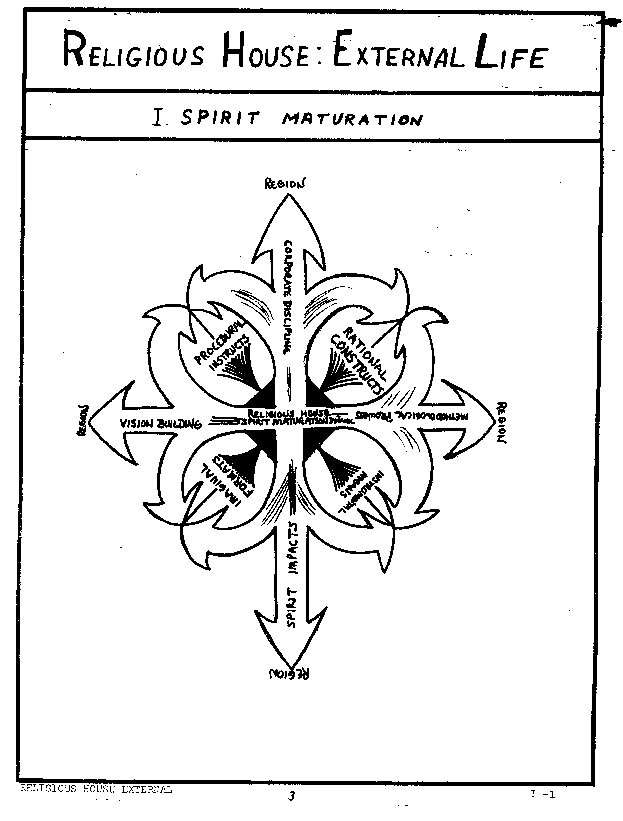
| Research Paper,
Research Assembly
Summer '72
Research Publication |
| |
| INTRODUCTION
I. SPIRIT MATURATION 1. Spirit Impacts 2. Vision Building 3. Methodological Training
4. Corporate Discipline
II. STRUCTURAL CATALYSIS 5. Care Modules 6. Penetration Enablement 7. Formulation Enablement
8. Permeation Enablement
III. GALACT I C FO RMAT I ON 9. Corporate Cleric Consultation 10. Auxiliary Formation 11. Galactic Nurture
12. Ecclesiastical Relations
IV. GLOBAL PRESENCE 13. Comprehensive Context 14. Resource Development 15. Comprehensive Symbology
16. Research Interchange CONCLUSION | 1
3 4 7 9
10
14 14 19 23
25
30 30 31 32
33
34 34 37 39
40
45 |
| RELIGIOUS HOUSE EXTERNAL OPERATIONS |
| INTRODUCTION | |
| This manual has been created as a comprehensive tool for the many roles the Religious House must play in its external life. Practical constructs have been laid out in a universal context to ensure that the Religious Houses worldwide are one common dynamic. The manual is designed to enable the Religious Houses to be the glue that holds the Order accountable to its mission. It delineates the mission into its several areas and enables House members to attain thecommon wisdom and common memory needed to intensify their spirit journey, thereby creating corporate discipline in a global missional force. Finally, this manual symbolizes the decision of the spirit movement of the twentieth century to be engaged in the civilizing process on behalf of all men. | |
SPIRIT MATURATION OF COLLEAGUES | |
| The practical spirit maturation of movemental colleagues is enabled through the continual impact of spirit tools such as singing, liturgy and celebrations. Corporate Discipline: The assignment in and through the structures with regular missional accountability enables the internalization of a corporate disciplined style. Vision Building: Vision is created and sustained through context expansion when encountered with the global demands in missional engagement. Methodological Training: The House is a constant methodological resource through its presence as priest, pedagogue, guru, and prior. | |
| STRUCTURAL CATALYSIS OF REGION | |
| Care Modules: The entire region is assigned to care modules' a movemental dynamic created by teams composed of the House. the secularreligious, and the local movement. Penetration Enablement: Regional penetration is enabled by assigned teams and individuals operating out of a pedagogical stance. Formulation Enablement: Formulation enablement is provided by task forces and training programs. Permeation Enablement: The task of permeation is enabled through vocational recontextualization and liaison with secular structures. | |
| GALACTIC FORMATION OF LOCAL CHURCH PROJECT | |
| Corporate Cleric Consultations: The initiation and expansion of the Local Church Project is the primary responsibility of the Religious House and is begun with any given local church through the corporate cleric consult. Auxiliary Formation: The auxiliary which is called forth from the cadre to engage in the project is nurtured and sustained by the Religious House auxiliary prior dynamic. Galactic Nurture Weekly sodality and biweekly Week II Council meetings of the galaxy are the primary responsibility of the Religious House auxiliary prior who provides the spirit and methods necessary for training and engagement. Ecclesiastical Relations: He is furthermore responsible for those relations with the church hierarchy necessary to maintain an adequate context for the project to
progress. | |
| GLOBAL PRESENCE OF MOVEMENT | |
Comprehensive Context: The religious house demonstrates its global presence to the region by providing a comprehensive context that holds and directs global strategies and continental priorities. Resource Development: It also cultivates and develops resources within the region for the global mission and addresses the region with comprehensive symbology. Research Interchange Center: A research interchange center insures a flow of information through the house and releases the wisdom of the regions for the practical creation of the New Social Vehicle and New Religious Mode systems and designs. MANUAL EXPLANATIONS: Where possible in the manual concrete helps have been listed and are indicated with small letters as follows (a) Rational Constructs (b) Imaginal Formats (c) Procedural Instructs (d) Instrumental Means | |
 |
| I. SPIRIT MATURATION 1. SPIRIT IMPACTS | ||||
| The spirit maturation of movemental colleagues is enabled through the continual use of spirit tools such as singing, liturgy, and celebrations. | ||||
| INTENTIONAL
CELEBRATIONS | 1. Celebrating in an intentional manner creates a spirit happening and provides an example of corporateness.
(b) 1) Construct dramaturgy chart (c) 1) Theme selection 2) Role assignment 3) Preliminary contexting 4) Supply procurement 5) Closing ritual | |||
| MOVEMENT
SINGING | 2. Movement singing, when adequately contexted, is a powerful spirit framework for external house activities. (c) 1) Context nonprofessionalism 2) Introduce new songs to region 3) Select songs intentionally 4) Context each song to the present 5) Orchestrate song | |||
| PRIESTING
STYLE | 3. Priesting style is exhibited by house members in their contacts with those outside the religious house dynamic, by offering to others the possibility of spending their lives intentionally. (a) 1) Priesting style chart: | |||
|
| Embody
Collegiality Push Radical
Lucidity Demand Life Decision | ||
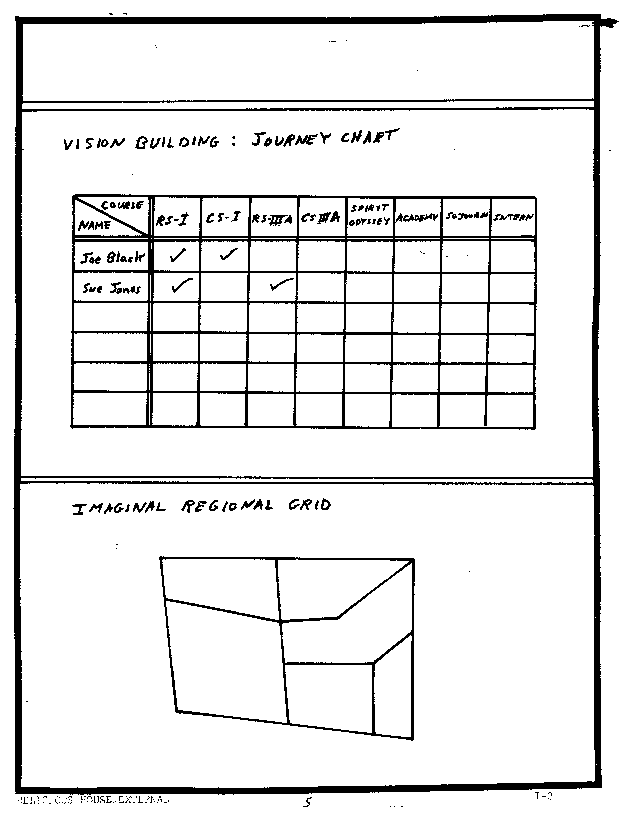 |
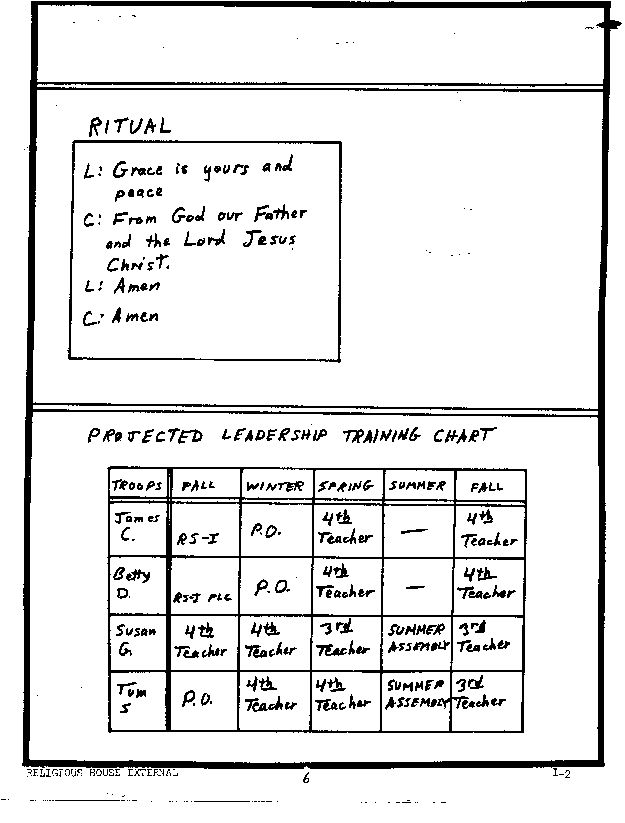 |
| OTHERWORLD MYTHOLOGY | 4. The OtherWorld Mythology is the compilation of stories, based on the spirit treks, which the religious house uses in lectures and short courses in order to impact regional people with the experience of their spirit deeps.
(c) (1) At first, teach only the four main OtherWorld categories: Land, River, Mountain, and Sea. (2) Shortcourse the Other World Chart strategically. (3) When discussing OtherWorld Mythology, always state clearly that the Other World is in this world. (d) (1) Use Summer '72 Trek Lecture papers. |
2. VISION BUILDING | |
JOURNEY CHARTS | Vision is created and sustained through context expansion: encounter with the global demands in missional engagement.
5. To enable the spirit growth of regional colleagues, journey charts are helpful in informing the Religious House as to the roles in which persons need to be engaged. (b) (1) A sample journey chart is on page 5 |
| MISSIONAL ROLE ASSIGNMENT | 6. Missional role assignment charts are another aid useful in allowing regional colleagues to make commitments to the movemental mission.
(b) (1) See the sample Leadership Training Chart, page 6.
(2) Charts giving colleagues the opportunity for assignments during a quarter on an optional basis are also helpful in this area of training. See the sample Track Chart on page 5. (3) Regional grids are helpful in imaging where assignments are to be made. These have been used in workshops to enable colleagues to get a mental grasp of their own region and metro. |
| GLOBAL
IMAGES | 7. The Religious House external life as expressed through use of decor and individual dress constantly exposes regional colleagues to global images. (b) (1) Create schematic diagram to hold all decor needed within the house and name the rooms in the house.
(2) Create yearly decor calendar holding all celebrations and special events; state the major emphasis for each month. (See Internal Life Manual, Primal Decor section.) (c) (1) List specific decor to be used for each room for each quarter. (2) Assign persons to create and set up decor in each room. |
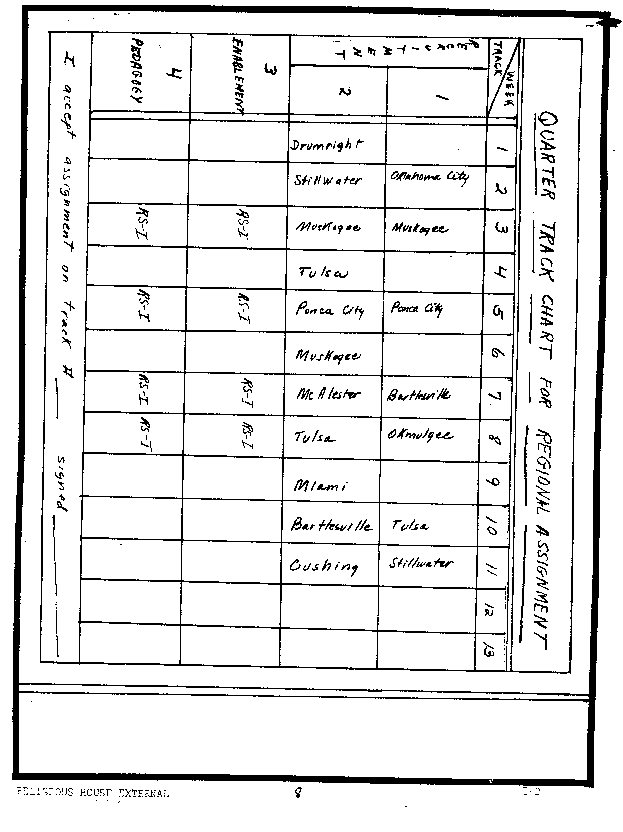 |
| ADVANCED
TRAINING PARTICIPATION AND SOJOURNING | 8. The Religious House creates models of recruitment to enable regional colleagues to decide to participate in advanced training and the sojourning experience, and spends time recruiting participants,
(b) (1) Create data holding chart. (See Chart p. 10) (c) (1) Gather grad data regarding course participation and compile recruitment list. (2) Decide key courses needed by every colleague (3) Recruit colleagues: a. Personal visits 1. Make appointment 2. Create pitch for course 3. Create and take course brochures 4. Limit calls to thirty minutes 5. Record call on 3" by 5" card and put in file for future reference. b. Telephone calls 1. Decide flow of call 2. Write down key point to stress 3. Place call 4. Record call data on 3" by 5" card and put in file for future reference.
c. Mail course brochures to all colleagues; follow up by personal visit or phone call. (d) (1) For sojourner recruitment see Summer '72 Manual #3. |
3. METHODOLOGICAL TRAINING | |
| The house is a constant methodological resource through its presence as priest, pedagogue, guru, and prior. | |
| SPIRIT
CONVERSATIONS | 9. Through use of spirit conversations and training regional colleagues to lead spirit conversations, the religious house enables colleagues to deal with their lives and trains them to be a spirit presence amidst other meetings of which they are a part. (d) (1) See spirit methods paper by George West. |
| SCRIPTURE
USAGE | 10. The Religious House will expose regional colleagues to the yearly lectionary of the order and lead and train them in the scripture conversation methodology. (d) (1) See spirit methods paper by George West. (2) See Order Yearly Lectionary. (3) See Summer '71 Guru Guide. (4) See Summer '72 Corporate Life Guide. |
| NRM
MUSES | 11. The Religious House will enable colleagues to participate in and learn to lead others in participating in the NRM (New Religious Mode) Muses. (d) (1) See George West's paper on "Spirit Methods." |
| OTHERWORLD
VISITS | 12. The Religious House will use OtherWorld visits amidst regional meetings in order to enable colleagues to participate in the visit and train to lead others in such an activity. (d) (1) See Summer '72 Ecclesiola Guide. (2) See Summer '72 Congregation Guide. (3) See Summer '72 Corporate Life Guide. |
4. CORPORATE DISCIPLINE | |
| The assignments in and through movement structures with regular missional accountability enable a corporate disciplined style. | |
| CORPORATE
ASSIGNMENT | 13. The Religious House understands itself to be under assignment by the movement to care for the region, and the house constructs a chart that holds the house accountable to concrete tasks.
(c) (1) List and prioritize regional tasks. (2) Maintain list and description of personnel available for assignment. (3) Criteria for assignment: -Gifts of colleagues
-Talents that need to be developed
(4) Assignments consensed upon by group or selected representatives. (d) (1) See assignment chart on page 14. |
| ACCOUNTABILITY /ABSOLUTION | 14. The Religious House provides the common context and initial forms for preparing the accountability/absolution ritual, allowing the ritual to be appropriately adapted and performed across the region. (c) (1) Introduce common context, purpose of ritual. (2) List appropriate occasions and gatherings (e. g. ecclesiola) (3) Delineate roles asking question and pronouncing absolution. (4) Provide examples of ritual questions and absolutions.
(5) Include suggestions for adapting to specific situations and common experiences. (d) (1) See also "Corporate Life Manual." |
| TIME
DESIGN | 15. Through its comprehensive time design, the Religious House brings order to its corporate assignments and stimulates regional and galactic structures to intentionalize the imaginal shaping of time out of the understanding that all time is missionally assigned.
(c) (1) Begin with fouryear timeline, thenbreak down into oneyear, quarterly, and weekly divisions. (2) Hold movement commonality: quarter divisions, Week I, Week II.
(3) Include councils, galaxy weekends, courses, and consults. (d) (1) See yearly, quarterly, and weekly timedesign charts, pages |
| CONSENSUS
OBEDIENCE | 16. The Religious House holds itself and the regional structure accountable to operating out of the consensus methodology of decisionmaking. |
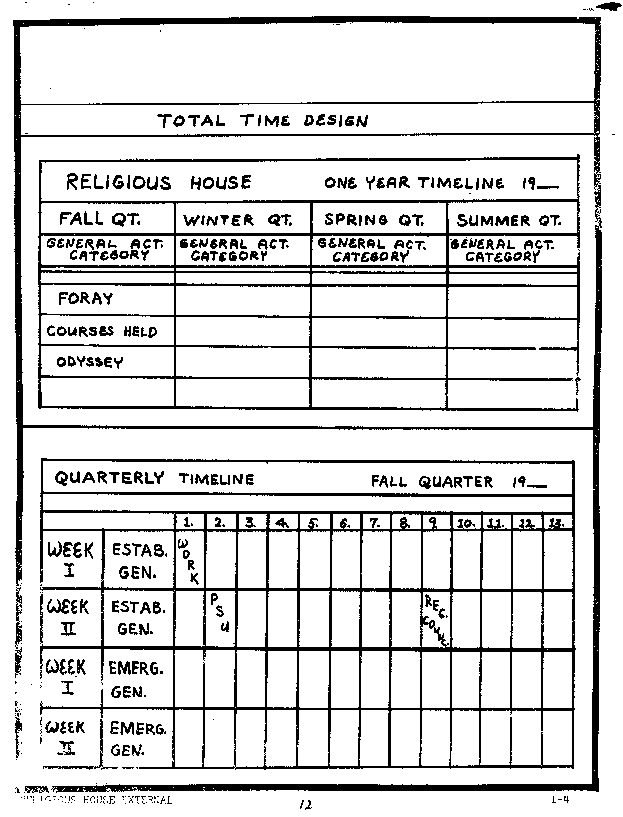 |
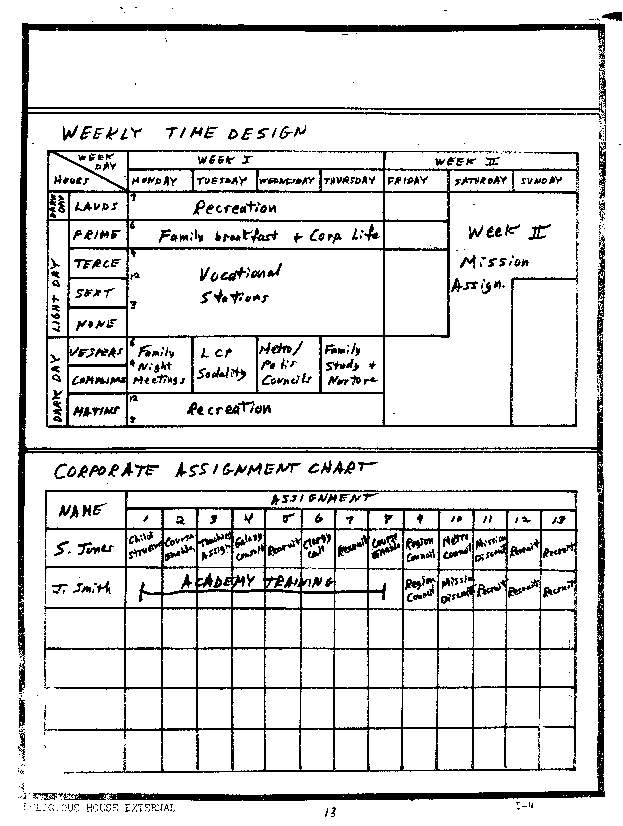 |
II. STRUCTURAL CATALYSIS 5. CARE MODULES | |
| GEOGRAPHIC
COVERAGE | 1. This comprehensive dynamic cares for the entire region by dividing it (by Metros or BiMetros) into specific arenas of responsibility for each of 6 or 3 modules.
(a) Rational constructs for that division are (1) Module Grid Metro (2) Module Grid BiMetro (b) An imaginal format is
(1) Regional Module Grad Location Grid for Metro & BiMetro. (c) Procedural Instructs are (1) Locate all grads (2) Grid Region by position and number of grads. (3) If there are weak Metros, create BiMetros. (4) If all Metros are strong use a Polis Module System. (d) Some instrumental means are these: (1) Maps (2) Journey Card File. (3) Development Printouts. |
| COMMON
APPROACH | 2. A common approach to module operation across the region would include:
(a) (1) Common time design construct (2) Contact/consult format
(3) Visitation procedures
(b) Modular Grad Location Grid (c) (1) Hold regional meeting of Metro leadership (2) Brainstorm possible meeting formats (3) Brainstorm possible time designs, weekly or biweekly (4) Consense on overall time designs and formats (5) Evaluate Journey Card Files and brainstorm needed visits
(6) Consense on a comprehensive visit procedure for the whole region. (d) (1) Journey Card Files for leaders and grads (2) Boston Region Manual, August 16, 1971, Tactical Arena, Module Care Section. (3) Summer '72 Ecclesiola Guide (4) Manual 1, Ecclesiola |
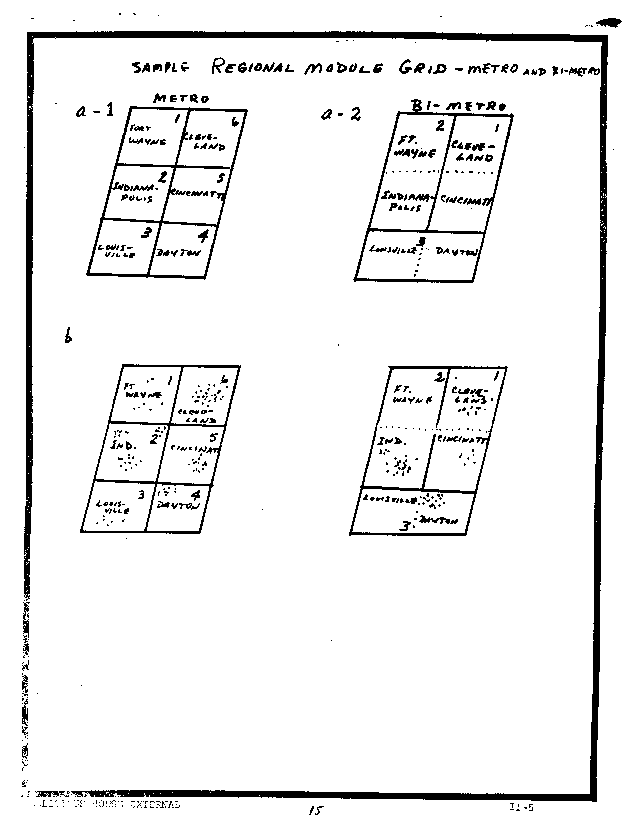 |
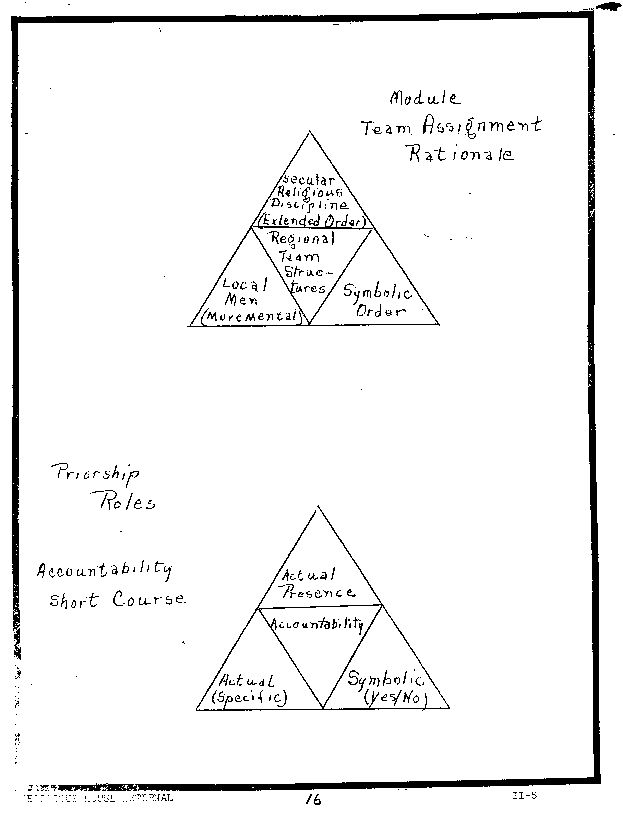 |
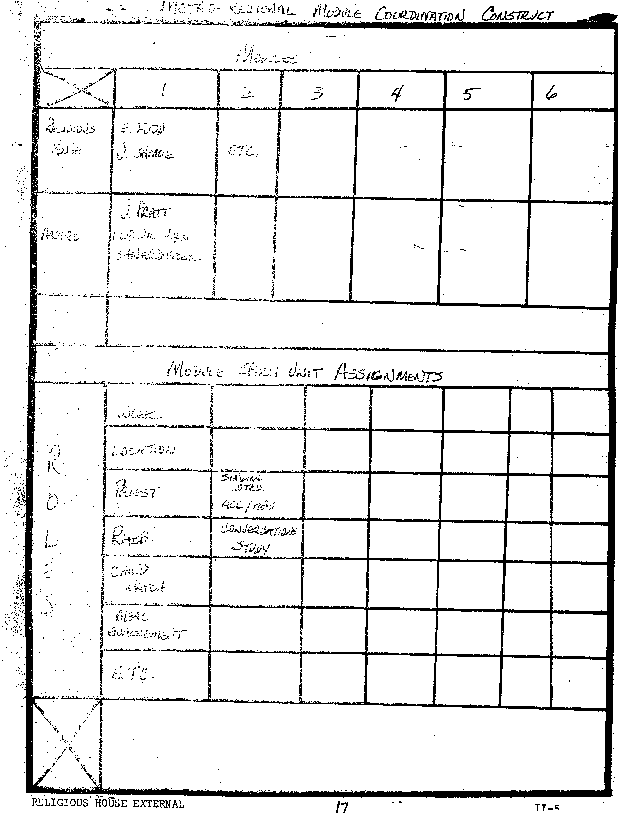 |
|
| NOTE: Team assignment chart not legible on scanner | |
| ASSIGNMENT
DESIGN | 3. The module assignment design organizes the assignment of family units from the House and the Metro to create a dynamic which catalyses the collapsed regionalis to be about enlivening the spirit. Some means of organization would be: (a) (1) Modular coordinators construct (2) Module Spirit Unit assignment construct
(3) Module calling team assignment construct (b) (1) Imaginal journey charts
(2) Imaginal journey cards . (c) (1) Evaluate journey cards of Metro and Polis leadership (2) Assign priorship and enablement roles
(3) Evaluate cards and assign calling teams (d) (1) Journey charts on leaders and all grads (2) Quarterly module visitation procedure. |
| RECORD
INTERCHANGE | 4. A comprehensive prayer system to include all grads in the Region would be established through careful record keeping and data interchange done through the weekly spirit unit meeting and/or a standardized contact report form.
(a) (1) A journey card maintenance and update system. (b) (1) Contact/consult form
(2) Sample journey card (c) (1)Initiate a journey card for each new course grad or new arrival in the area. (2) Send that information to central data system. (3) Have a report session at Spirit Unit meeting or submit a report form to recorder. (4) Record reports on journey cards (5) Put weekly report of visits and phone calls on ditto (6) Send the ditto to a central place (7) Assigned person runs ditto off and sends it to all involved
(8) Put information on central file cards. (d) (1) File cards (2) Agenda slot for reporting (3) Assigned scribes and/or recorders (4) Standardized report forms |
| 6. PENETRATION ENABLEMENT | |
| TEAM
ASSIGNMENT | 5. The house is an intentional presence in the Region through regular team assignments to visitations, forays, blitzes, and course enablement. (a) Here is a way of organizing:
(1) Penetration Team Assignment Chart Week I - II. (b) The Quarterly Timeline gives basis for assignments. |
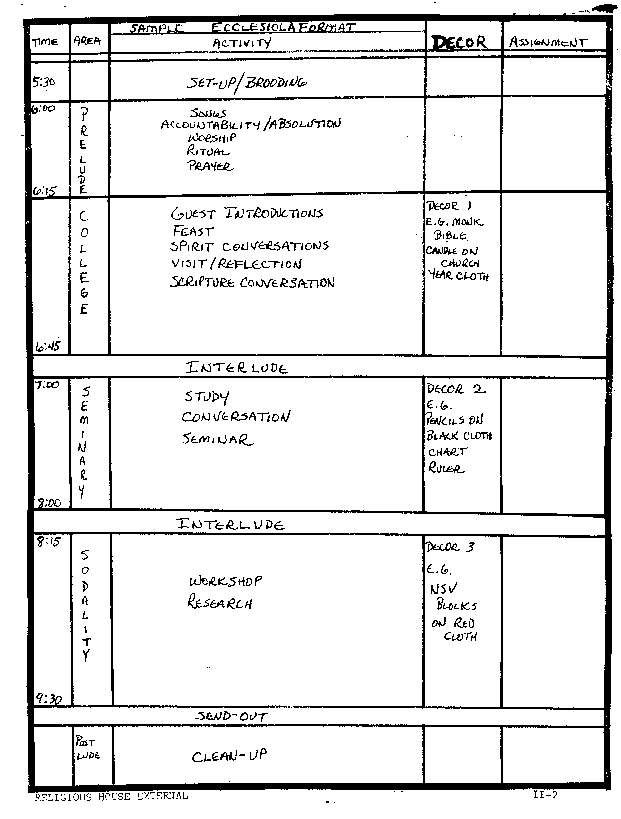 |
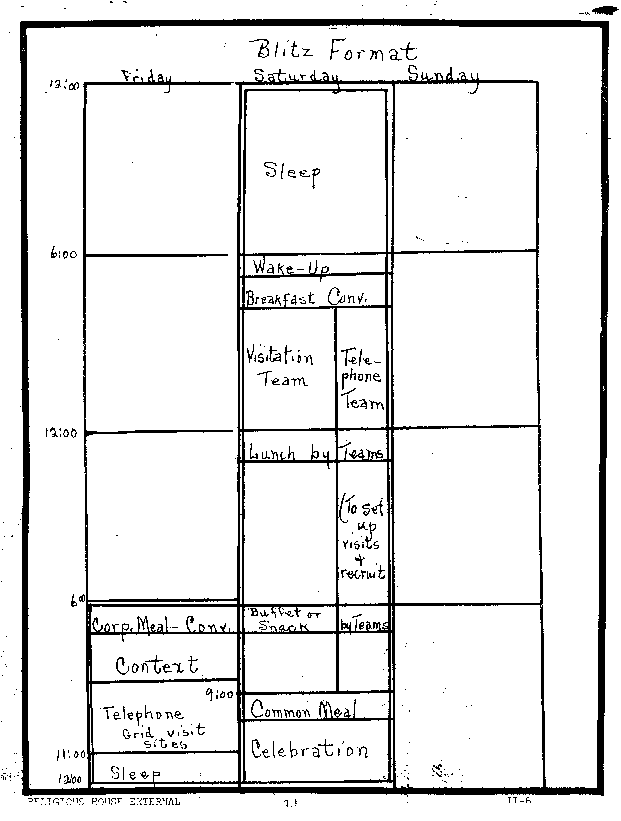 |
| (c) Suggested procedure would be
(1) Check Quarterly Time Line
(2) Make travel plans accordingly (d) (1) Cars (2) Files (3) NRM Charts (4) Plenary Report by J. W. Mathews, Summer '72. | |
| E.I. STORY | 6. E.I. Story enables penetration of the region by keeping movement colleagues aware of who they are at all times and sharing movemental practical objectives as well as movemental vision at all gatherings. This would involve:
(a) (1) Story transmission strategy
(b) (1) Imaginal time line (c) (1) Gather data (2) Brainstorm (3) Gestalt
(4) Write the Story (d) (1) Tracts (2) Presidium reports (3) State of the Movement by J.W. Mathews (4) Global Report by Fred Buss |
| PEDAGOGICAL STANCE | 7. The Religious House members embody and are "out to win" with a pedagogical stance which, through catalyzing timeline obedience and utilizing training and stories enables the regional penetrators to recruit strategically, reimaging human possibilities. (a) (1) Mood orchestration construct (recruitment blitz) (2) Recruitment report form
(3) Recruitment pitch model (c) Suggested procedures to set the tone of "success" at all recruitment structures are: (1) Check Penetration Manual
(2) Hold Regional recruitment coordinators accountable through phone calls and meeting reports. (d) (1) Recruitment pitch models (2) Penetration Manual #7 (3) Recruitment report forms (4) Common Movement History Stories, re. Imaginal Timelines. |
| SPECIAL FORMATS |
8. Special formats consists of a team with House and Regional representation to analyze and evaluate the given region to enable the actualization of strategic penetration. Places where this team might operate are: |
| (a) (1) Meeting assignment model
(c) (1) Determine the needs (2) Make assignments (3) Set up appointments (4) Check style chart (d) (1) Short courses (2) Brochures | |
7. FORMULATION ENABLEMENT | |
| TASK
ASSIGNMENTS | 9. Task Force assignments are built to enable regional structures.
(a) (1) Enablement Assignment Construct (c) (1) Identify specific enablement tasks to be assumed (2) Determine the immediate needs and available troops (3) Organize troops (4) Implement plans
(5) Make assignments (d) (1) Quarterly timeline (2) Personnel (3) Geographic grids (4) Transportation models (5) Financial models |
| MOVEMENTAL
TRAINING FORMS | 10. Movemental training forms will provide structures to train Regional task force personnel engaged in material structure. (a) (1) Movemental training curriculum (b) (1) Progress charts (c) (1) Recruit forces for (2) Advanced courses (3) Academy (4) Research
(5)Pedagogy (d) (1) Training Manuals (2) Movemental methodology (3) Research materials (4) Council documents (5) Recruitment grid |
| PRIORSHIP
ROLES | 11. The Religious House shares movement practical objectives and vision and enables spirit consciousness in the region through the priorship roles in corporately planned agendas.
(a) (1) Priorship role plan (b) (1) Accountability Short course |
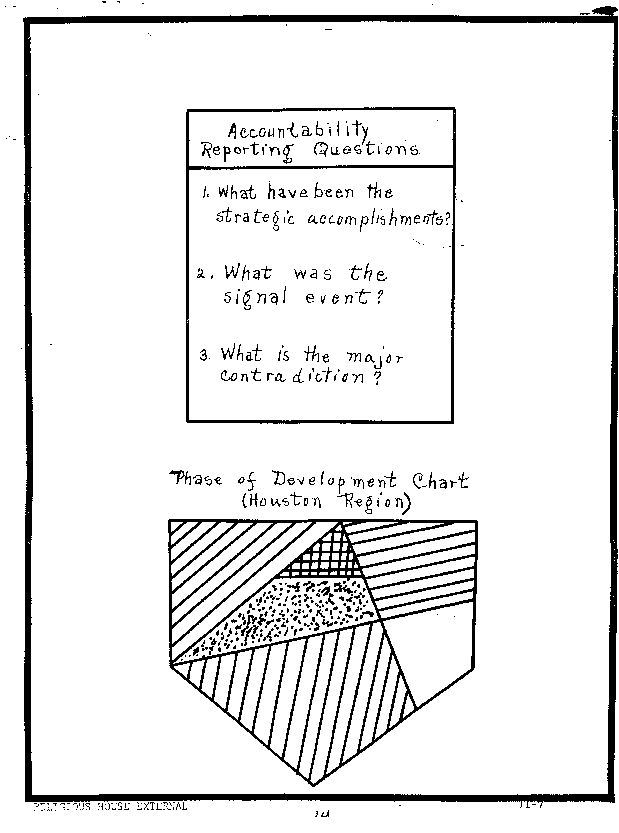 |
| (c) (1) Participate in corporate agenda planning
(2) Evaluate and assign House members
(3) Assume priorship roles (accountability ~ absolution (d) (1) Other assignment models (2) Meeting time and place charts (3) List of House members (3) Agenda planning meeting | |
| CONCILIAR
FORMS | 12. The Religious House enables the formation of and recruitment for Movemental Councils and Research Assemblies. (a) A rational construct includes: (1) Regional Coordination Chart (2) A recruitment model
(3) Delegation assignments (c) (1) Quarterly consultation (2) Movement research (3) Travel plans
(4) Children's structures (d) Instrumenta1 means are: (1) Council documents and manual 12 (2) Brochure assignments (3) Meeting places (4) Travel pools (5) Decor (6) Symbols (7) Grids of Region and Polis |
| 8. PERMEATION ENABLEMENT | |
| MOVEMENT/
ESTABLISHMENT LIAISON | 13. The Religious House enables its members to function as liaison (people) between the movement and establishment in order to release their gifts as an essential contribution to the spirit movement and facilitate their understanding of the movement. (a) (1) Prioritized list of establishment structures
(2) Timeline of liaison contact
(b) (1) Liaison imaginal Grid (c) A suggested list of procedures for liaison (1) Use Summer '72 Systems to discern missional demand in relation to particular establishment structures. (2) Assign House personnel who have related experience and/or previous contacts with the structure. (3) Assign personnel & create a contact format (4) Arrange time/place/enablement for meeting |
| (5) Evaluate contact
(6) Plan followup in relation to evaluation e.g. further direct contact and mailings
(d) list of instruments to enable these procedures: (1) Telephone calls (2) Conferences (3) Mailing lists (4) Social gatherings (5) Summer '72 Tactics Manual | |
| ADVISORY
CONSULTS | 14. An Advisory Consult is an encounter between members of the Religious House and members of other societal structures in order to spread the new secular mythology and methodology to a broader spectrum of society and show concern for local man.
(a) Advisory consult curriculum chart (b) Imaginal Formats include:
(1) Anticipated consultations made in a particular social process arena. (c) Suggested list of procedures for a consult: (1) Prioritized list of advisory contacts and church and societal groups (2) Approach agency or consult in relation to specific movement "program" (3) Set a date/place for group or consult (4) Assign personnel in relation to missional demand (5) Create the consult or course format
(6) Evaluate consult or course (d) (1) Popular preaching (2) E.I. Methods workshops for Sunday School teachers (3) New Individual ~ the New Society course constructs (4) Consult evaluation forms |
| GUILD
COMPLEX ASSIGNMENT | 15. The Religious House external dynamic enables the Guild Complex through the assignment of skilled order members to the guild. The assignments are held in a (a) (1) Guild Enablement Construct which is based on a (2) Guild Tactical Designs Chart (b) (1) Guild Symbols
(2)Guild Stories (c) The procedures for this enablement are outlined in
(1) Summer '72 Tactics Manual and Guilds Manual (d) Means for enabling Guild Complex assignments are (1) Summer'72 Tactics (2) Local Church Project Tactical Systems |
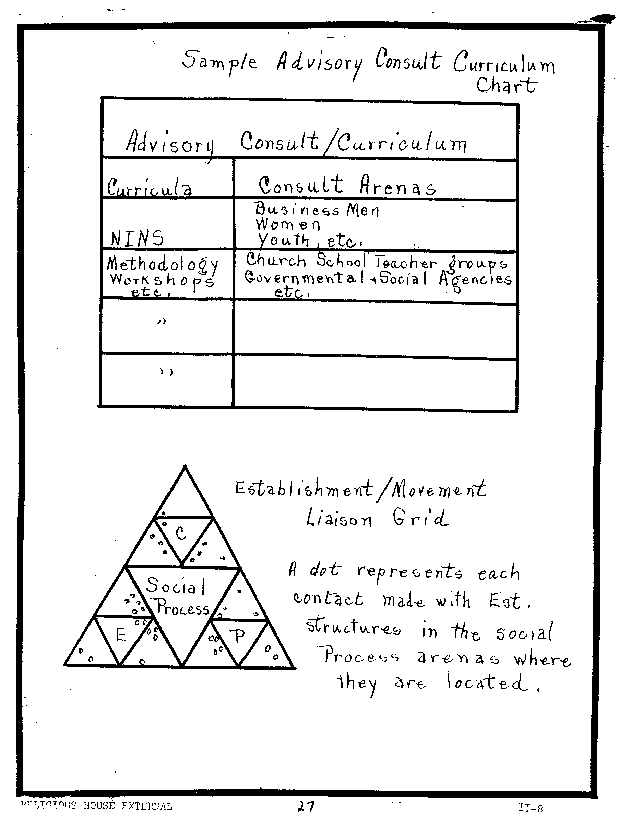 |
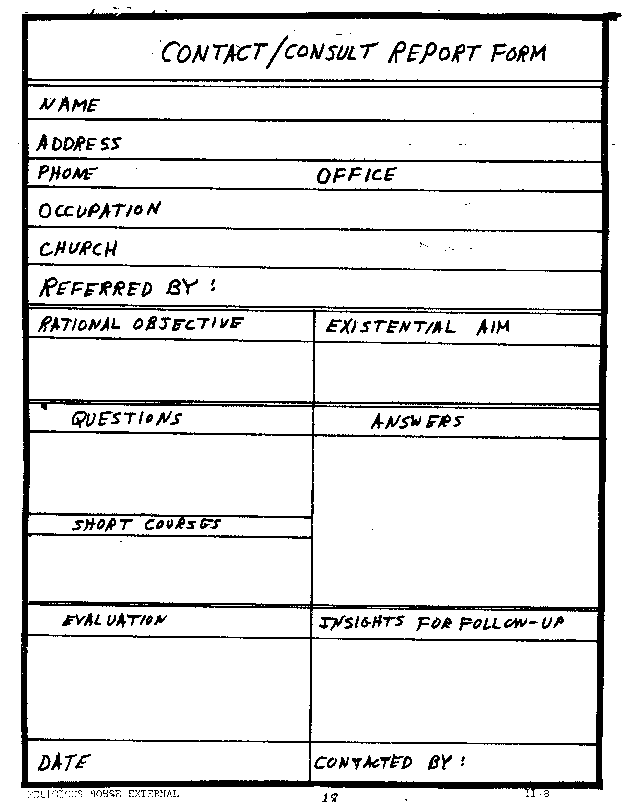 |
| VOCATIONAL
RECONTEXTING | 16. Vocational recontexting is related to Religious House External dynamics by the use of contextual reeducation methods directed at vocational arenas through the implementation of (a) (1) Minute curriculum design in relation to Summer '72Tactics
(2) Methodological training workshops for agencies engaged in contextual reeducation programs in schools and offices.
(b) (1) Brochures (c) (1) Plan recontexting in relation to missional demands and Religious House yearly/quarterly goals (2) Locate or create movement involvement in target groups (3) Outline 4 year/yearly/quarterly goals for group (with the target group) (4) Create and Timeline group program
(5) Assign House personnel (d) (1) New Individual and the New Society and advance courses (2) Movement timeline and priorities (3) Summer '72 popular preaching short course manual minute curriculum (4) Media publicity |
III. GALACTIC FORMATION 9.CORPORATE CLERIC CONSULTATIONS | |
| Corporate Cleric Consultations are an aspect of the basic groundwork for Auxiliary formation in the prospective galaxy churches. | |
| CLERGY FAMILY
ASSIGNMENTS | 1. The Religious House enables the clergy family to understand itself as movemental churchmen assigned to its particular congregation and thereby to assume a disciplined relationship with the movement. (c) (1) Contacts for appointment made with PLC grads (2) Forma1 or informal meetings can include: dinners at restaurant, coffee shop, invitation to Religious House, visit to clergy residence, or office. (3) Contexting or explanations given early in series of contacts (4) Luncheon or dinner for clergy groups for contexting (5) Methods developed to deal with nonmovemental spouse (6) House keeps journey chart on family
(7) House informs and recruits family for House and regional programs House assigns clergy family to congregation (a) See Spirit Maturation Journey Chart |
| CADRE
CONSULT | 2. The cadre consult is the initial contexting by the Religious House of the clergy family, RSI grads, and other potential leadership. (c) (1) Religious House establishes date for consult (2) Arranges location (3) Organizes children's structures (4) Plans and creates decor (5) Procures and prepares food (6) Enables transportation (7) Actualizes format |
| MOVEMENT
CONTEXTING | 3. The Religious House enables the cadre to see itself as part of the global movement through RSI and advanced courses and introduction to symbolic life, study life, common memory, and time/space design. (c) (1) RSI participation (2) Advanced course participation (3) Introduction to: songs, symbols, decor, charting, timelining, corporate study, art form methodology, rituals, spirit methods |
| CONGREGATIONAL AWAKENING | 4. The Religious House impacts the congregation directly through speaking engagements, consultations, and strategic visits to effect a positive relationship with the movement.
(c) (1) Assignment of house members to a Sunday service (2) Members should assume intentional dress and decorum (3) Solicit speaking engagements ~ (4) Procure church calendar and/or yearbook (5) Prior visits church |
| 10. AUXILIARY FORMATION | |
| Auxiliary Formation is the second phase of galaxy formation and deals with decisions of members and clergy of all the galaxy churches to participate in the Local Church Project. | |
| FIELD
CONSULT | 5. The field consult allows the cadres of the four prospective galaxy churches to decide about their participation in the Local Church Project in the context of the continental experiments. The Religious House enables the field consult through setting the date, securing the facilities, and doing the necessary practical preparation.
(c) (1) Set date with Regulation Centrum (2) Enable and host meeting (3) Provide children's structures (4) Enable transportation |
| TRAINING
SCHOOL RECRUITMENT | 6. After the initial groundwork has been laid in the cadre for the decision to participate in the Project, the Religious House enables representative cadre members to attend the continental basic training school. (c) (1) Contexting continental project (2) Initiating a corporate financial model (3) Catalyzing children's structures (4) Ensuring transportation arrangements |
| REGIONAL
ASSIGNMENTS | 7. In order to establish the auxiliary as part of the global movement, the Religious House invites participation in house and movemental functions: house church, global research in the house and summer programs, regional councils, advanced courses and penetration. By participating in regional activities, the auxiliary is enabled in their journey to replicate the project (see Religious House Tactic Book). (c) (1) See LCP training units (2) Give auxiliary participants context for seeing themselves as needed at regional council and house functions (3) Enable participation through child structure (4) Transportation enablement (5) Create uniform assignment rationale with accountability/ absolution structures |
| PRIORSHIP
CONSULTATION | 8. The Religious House enables priorship training by consultation with the designated priors of each auxiliary unit on a weekly basis.
(c) (1) Set up regular meeting schedule (2) Decide strategic meeting place (3) Insure intentional missional decor (4) Provide comprehensive global context |
11. GALACTIC NURTURE | |
| Galactic nurture is the priorship dynamic that sustains and spiritizes the local church auxiliaries, as the project participation intensifies. | |
| SODALITY
PRIORSHIP | 9. The Religious House assumes the priorship role in the weekly Tuesday sodality structure, which involves the auxiliary from each galaxy church in tactical actualization, pedagogical training, and spirit nurture. (c) 1) See quarterly LCP manual |
| WEEK II
COUNCILS | 10. Week II Councils which meet biweekly for evaluation and planning are a major setting where the Religious House enables galactic nurture. (c) 1) Enables children's structures (2) Housing provision (3) Hosts meeting (4) Priors act as consultants to auxiliary units |
| CONTINENTAL
CONSULT | 11. Once each quarter, the Religious House organizes and enables a continental consult with a team from Regulation Centrum and a representative from another galaxy. (c) (1) Coordinate transportation of incoming team (2) Celebrative menu and decor (3) See Week II Council procedures 1, 2, 3 (4) Follow specific instructions for this consult, usually by phone |
| ADVANCED
TRAINING RECRUITMENT MODEL | 12. The religious House recruits galaxy members for advanced training such as advanced courses, Academy, presidiums, advanced training school, and summer programs. (c) (1) Develop comprehensive timeline (2) Build recruitment model (see Summer '72 Recruitment Manual) (3) Build journey chart for prospective recruits |
12. ECCLESIASTICAL RELATIONS | |
| Ecclesiastical Relations involves the strategic contact between the local church project and the historical church. | |
| TACTICAL
VISITS | 13. The Religious House makes tactical visits to representatives of the established church in order to deal with anticipated problems, intending to elicit a positive attitude toward the galaxy formation. (c) (1) Get list of church officials in region (2) Prioritize key officials (3) Meet with local church pastors and decide strategy (4) Build calling models, including style, callers, and format (5) Make appointments (6) Record all contacts and results |
| STRATEGIC
PUBLIC RELATIONS | 14. Strategic public relations involves the release of information and reports to the established denominational structures in order to have their continued support of the project. (c) (1) Develop mailing list (2) Select strategic newsletters, reports, miracle stories, and bulletins (3) Determine list of sponsors 4) Determine most helpful communicationphone or mail |
| RESOURCE
SOLICITATION | 15. The Religious House solicits the financial assistance of established church bodies to enable the expansion of the LCP. (c) (1) Analyze resource possibilities (2) Create a proposal appropriate (3) Decide how much to ask for (4) Present to development target |
| STRATEGIC
CONSULTATIONS | 16. Strategic consultations with the historical church hierarchy are designed to secure their support of the project while soliciting their advice and assistance.
(1) Set context (2) Carefully select representative to call on officials (3) Honor their ecclesiastical role and their wisdom
(4) Raise the question for which you are consulting him Note: You are not asking him to decide for you, but finding out where he stands without making him make a decision. |
| IV. GLOBAL PRSENCE
13. COMPREHENSIVE CONTEXT | |
| Comprehensive Context is a perspective that holds a global view and an allinclusive approach to the issues of humanness. | |
| MOVEMENT
IDEOLOGY | 1. The Movement Ideology is the four basic ideological global stances. They are: "All the earth belongs to all the people all the goods of nature, all the decisions of history, and all the gifts of humanness.' (a) (1) Study of 'Toward a Practical Vision of the NSV' manual (2) Continual Lecturettes on the four basic ideologica1 statements. (3) Study of JWM's lecture presenting four ideological statements to Summer '71 Research Assembly. (4) NSV Social Process triangles
(5) Global Report by Fred Buss, March '72 (b) (1) Social Process Imbalances triangles
(2) Global Report (c) (1) Display charts and banners at meetings (2) Sing NSV Journey Song
(3) Imaginal presentation of the Four Basic Ideological Statements (d) (1) "Toward a Practical Vision of the NSV' manual (2) JWM's lecture presenting the four basic ideological statements to Summer '71 Research Assembly (3) Banners that hold ideological statements (4) NSV Social Process triangles |
| GLOBAL
STRATEGY | 2. Global strategy are the three strategic sociological areas of attack for global renewal. They are: Global Reconstruction, Church Metamorphosis, and Human Resurgence. [see Summer '72 Designs manual] (a) (1) Short course on pincer movement as outlined in Gene Marshall's lecture in Summer '72 of movement philosophy
(2) Global priorities expansion chart (b) (1) Workshopping guideline to problemat from global to local (2) Attack on world be consistent with churchworld pincer movement
(3) Global Odyssey (c) (1) Enable the region to set its regional priorities by giving contexts for priorities at many gatherings (2) have a workshop at regional council |
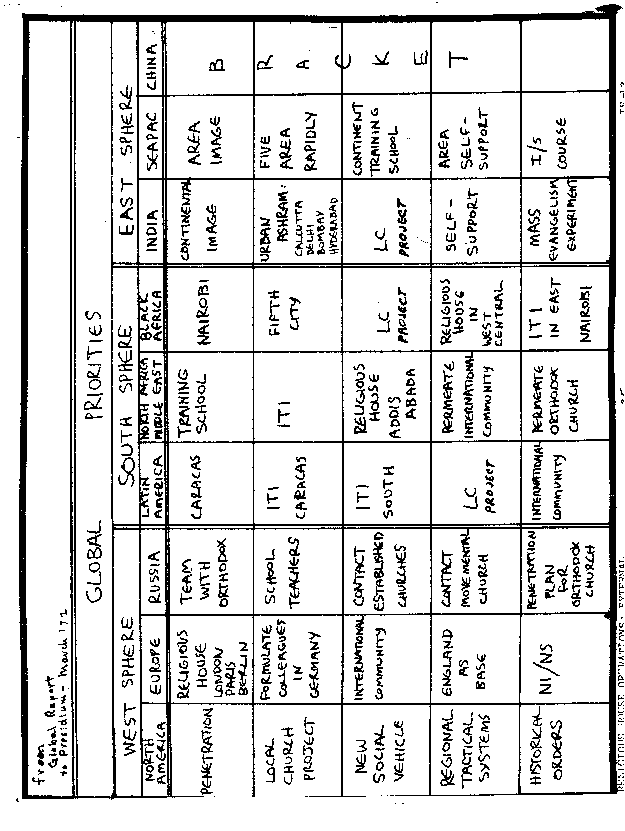 |
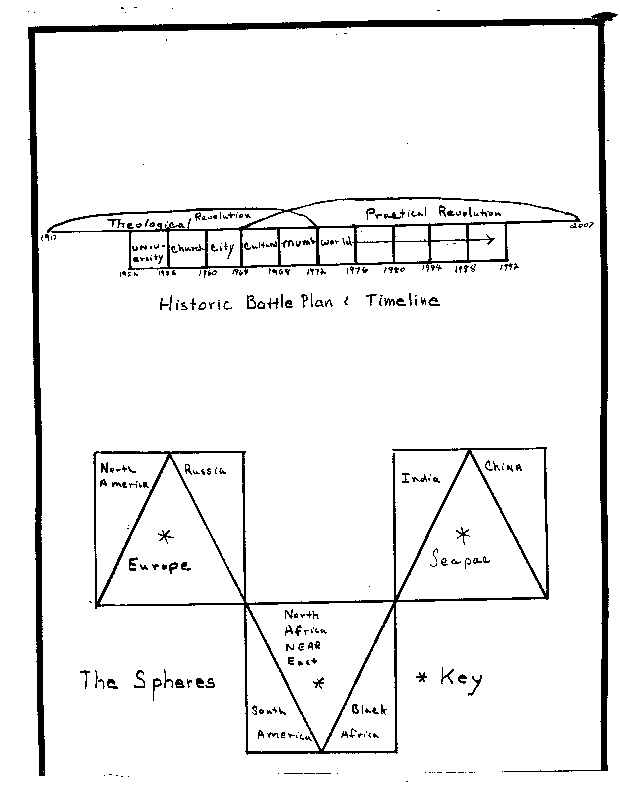 |
| (d) (1) Wall charts that state movement designs
(2) World Analysis grid (3) Regional grid (4) Nation/World course (5) Academy (5) Movemental Designs Manual | |
| CONTINENTAL PRIORITIES | 3. The five continental priorities are the major continental goals on the basis of which the Religious House enables the region to develop its priorities. (c) (1) Wall chart of continental priorities'
(2) Regional analysis in relation to continental priorities (d) (1) Wall chart with continental priorities (2) World grid and continental grid (3) Colorcoded phases analysis |
| HISTORIC
BATTLE PLAN | 4. The historic battle plan is an approach to the global strategies that is grounded in the wisdom of the past fifty years of theological and social struggle, and includes an ,imaginal and practical timeline for the next twenty years.
(a) (1) Cultural Revolutions lectures from CS1 (b) (1) 40204 year timeline
(2) Yearly/quarterly/weekly timeline (c) (1) Begin with what you want to accomplish rather than what looks feasible (2) Study pivotal theologians of twentieth century (3) Study all Summer Assembly documents since 1965 (4) Consider the wisdom of church leaders
(5) Recruit for CS1 (d) (1) CS1 (2) The Cultural Revolutions lectures from CS1 (3) Summer Assembly Documents since 1965 |
14. RESOURCE DEVELOPMENT | |
| Resource development is the releasing of untapped financial aid and human energy in order to support the programs of the movement. | |
| RESOURCE
GRID | 5. Resource grid is a construct for a given geographic area, basically a region, that holds all data in a computerize. analysis of movement contributions for the past ten years. (a) (1) List of contacts (2) Analysis of development progress in the area |
| (b) (1) Prioritized Donor List in given area according; to recent contributions, hot prospects, long shots. (c) (1) Cultivate prospective givers at group meetings such as Regional and metro gatherings, local church, etc.
(2) Visits with colleagues and friends to discover possible financial donors. (d) (1) Development Printout from Base Development coordination. (2) Card file on industries which have particular social interest for which they are willing to contribute.
| |
| PUBLICITY
DISTRIBUTION | 6. Publicity Distribution is a development enablement which, informs RS1 Grads, movement friends, and prospective donors of global imperatives and development emphases.
(b) (1) Comprehensive data flow chart (c) (1) Appreciate the gifts of the Establishment (2) Adapt story of need to interest of prospect (3) Synchronize regional mailing to coordinate with global development requests and team visits
(4) Organize and publicize small meetings such as cocktail parties, reception dinners, metro level dinner, Movemental development dinners (d) (1) Brochures on special programs, ea. The Fifth City Preschool (2) Bulletins on movement programs such as ITI (3) I.E. and Image (4) Donor Printout from Development Office |
| PROCUREMENT
BATTLE PLAN | 7. A Procurement Battle Plan is strategy to utilize grid information in order to build a model to raise a specified amount of money during a particular time period.
(b) (1) Battle Plan which plots (a) appointments (b) projected needs (c) desired individual and group gifts (d) visiting team
(e) coordination of geography with appointments (c) (1) Donors are called according to strategic Timeline (2) Build Battle Plan to hold all data, appointments, f/u (3) Organize and enable meetings, parties, dinners (4) Host and coordinate the global development teams visits (5) Keep record of progress (6) File records of gifts
(7) Plan for immediacy and long range followup (d) (1) Basic model for fund raising calls 2) cars for calling |
| ASSIGNMENT
OF TEAMS | (3) Evaluation sheets
(4) Thank you letters (5) Coordinator assigned to all Development activities |
| 8. Assignment of teams composed of one Development Office member and one region or house member is made to accomplish the development calls out in the Region.
(c) (1) Carefully consider prospects and match with time availability, strengths and weaknesses of team members to make team assignments. (d) (1) Coordination system for calls between Base and House
| |
15. COMPREHENSIVE SYMBOLOGY | |
| The movement creates symbols to keep itself chaste before its task and conversely the symbols recreate the movement. The external mission of the House includes keeping this symbology comprehensive. | |
| ENABLING
CORPORATE RITUALS | 9. The Religious House enables the movement to rehearse the way life is by holding before it the necessity to use corporate rites and rituals with every movement gathering from the smaller family unit to the annual regional celebrations.
(a) (1) Study gatherings (2) Action gatherings (3) Care gatherings (b) (1) Ecclesiola Guide S'72 (2) Congregational Guide S'72 (3) Local Church Project, Week II Councils any quarter (c) (1) S'72, Manual: Religious House Internal Life (d) (1) same as c (1) |
| INDIGENOUS
SYMBOL RECOVERY | 10. The task of catalyzing the re-appropriation of indigenous symbols which create humanness is effected by the House.
(a) (1) Community Symbol Guild (b) (1) Fifth City Model: Guilds (c) (1) Researching past symbols of the locale (2) Decide on a relevant symbol to present (3) Brainstorm methods to present it (4) Tell a story about it (5) Context the community or receive it (6) Build a model for continual presentation (7) Place on a timeline (8) Assignment to accomplish the task |
| (d) (1) Fifth City Model | |
| INTERPRETING
MOVEMENT SYMBOLS | 11. To enable the transference of common memory relative to use and meaning of Movement Symbols the House keeps its own decor practical and correct. (c) (1) Use symbols as decor in an appropriate manner (2) Recreate the symbol stories and tell them (3) Conduct conversations on symbols
(4) Context the use of symbols and use the symbols as contexts symbolizing activity.
(d) (1) Illustrations of some movement symbols on following pages |
| ENABLE
DECOR MODELS | 12. The Religious House enables any regional group to develop decor models for all regional functions in any location for all occasions. (a) (1) Establish motif to fit occasion (b) (1) Space design as to available area (2) Architectural design as to visual exposure (3) Design motifs (c) (1) Lay out the motif (2) Assign troops (3) Purchase materials (4) Context the situation (d) (1) Cloth materials (2) Paper materials (3) Adhesive substance (4) Tools of creation |
16. RESEARCH INTERCHANGE | |
| ASSEMBLIES
ENABLEMENT | 13. The Religious House enables the Research Assembly through its own participation in the preparation and actual happening of the summer program. (c) (1) Recruit regional participants (see recruitment manual) (2) Assign House members to the program (3) Correlate transportation (4) Build financial enablement model (5) Transmit wisdom and happening of the summer back to the House and Region |
| GLOBAL
RESEARCH ASSIGNMENT | 14. Valuable research is done on a global basis by all the houses as each one receives a particular assignment from Base Research Centrum. |
|
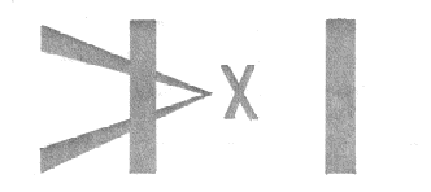
THE WEDGE BLADE represents mankind in the march of history from the no longer to the not yet. Within the ranks there exists the Church, the People of God breaking through leading all of God's people to create the future on behalf of all men.
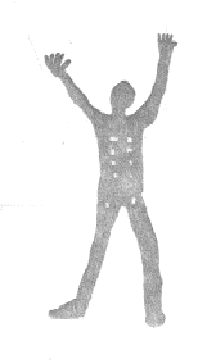
THE IRON MAN symbol came out of the Fifth City experiment. It symbolizes the Spirit Man who has decided to stand solitarily in the midst of life.